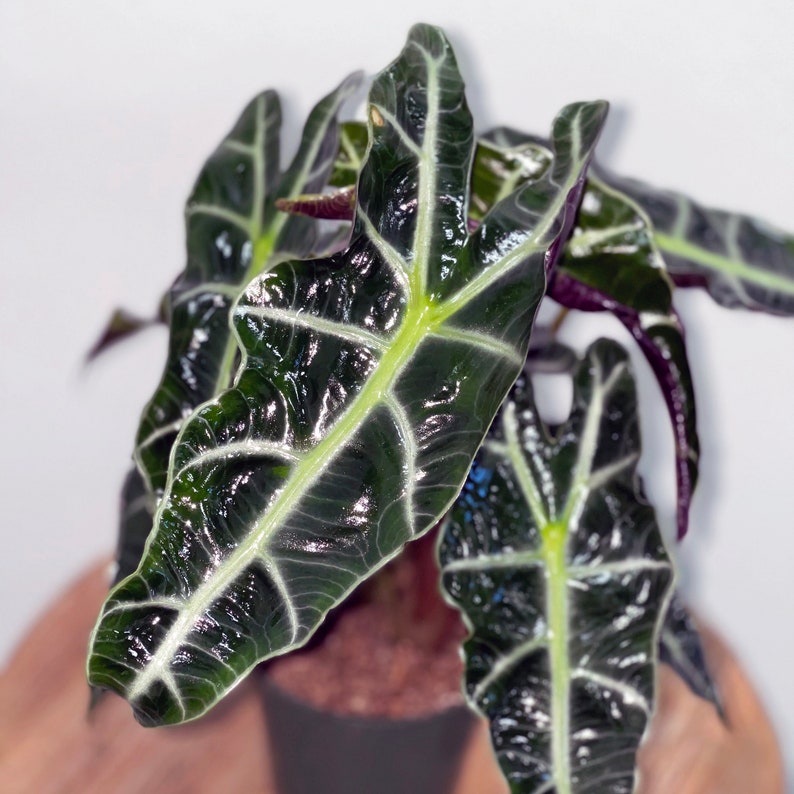The Alocasia plant, known for its stunning, elephant ear-shaped leaves, offers a bold statement that can transform any space. With their striking appearance and unique growth habits, these tropical beauties have become a favorite among houseplant enthusiasts.
In this guide, you’ll discover essential tips for caring for your Alocasia plant, including the best soil, light, and humidity requirements. I’ll also explore how to propagate, prune, and identify common pests and diseases that can affect your plant. Whether you’re a seasoned gardener or a beginner, you’ll find valuable insights to help your Alocasia thrive.
Ready to dive into the world of Alocasia? Keep reading to learn how to nurture these captivating plants and enjoy their dramatic foliage in your home!
5 Key Takeaways on the Alocasia Plant
- Alocasia plants, also called elephant ear plants, come from Southeast Asia. They have big, stunning leaves with bright veins. You can find them in different shapes and colors. Some popular types are Alocasia Polly, Silver Dragon, Red Secret, Purple Sword, Giant Taro, and Kris.
- Alocasia plants like warm and humid places. They grow from rhizomes and can quickly make new leaves. Alocasia prefers bright, filtered sunlight but can handle full tropical sunlight too.
- For the best growth, use a soil mix that includes coco coir, perlite, orchid bark, sphagnum moss, and worm castings. Keep the soil moist but not soggy.
- Keep daytime temperatures between 70-85°F (21-29°C) and nighttime temperatures above 60°F (15°C). Aim for high humidity levels, between 60-80%.
- Even during the dormant season in late fall and winter, continue caring for your Alocasia. Trim dead leaves and branches often. Repot the plant every year with fresh soil.
Overview of the Alocasia Plant
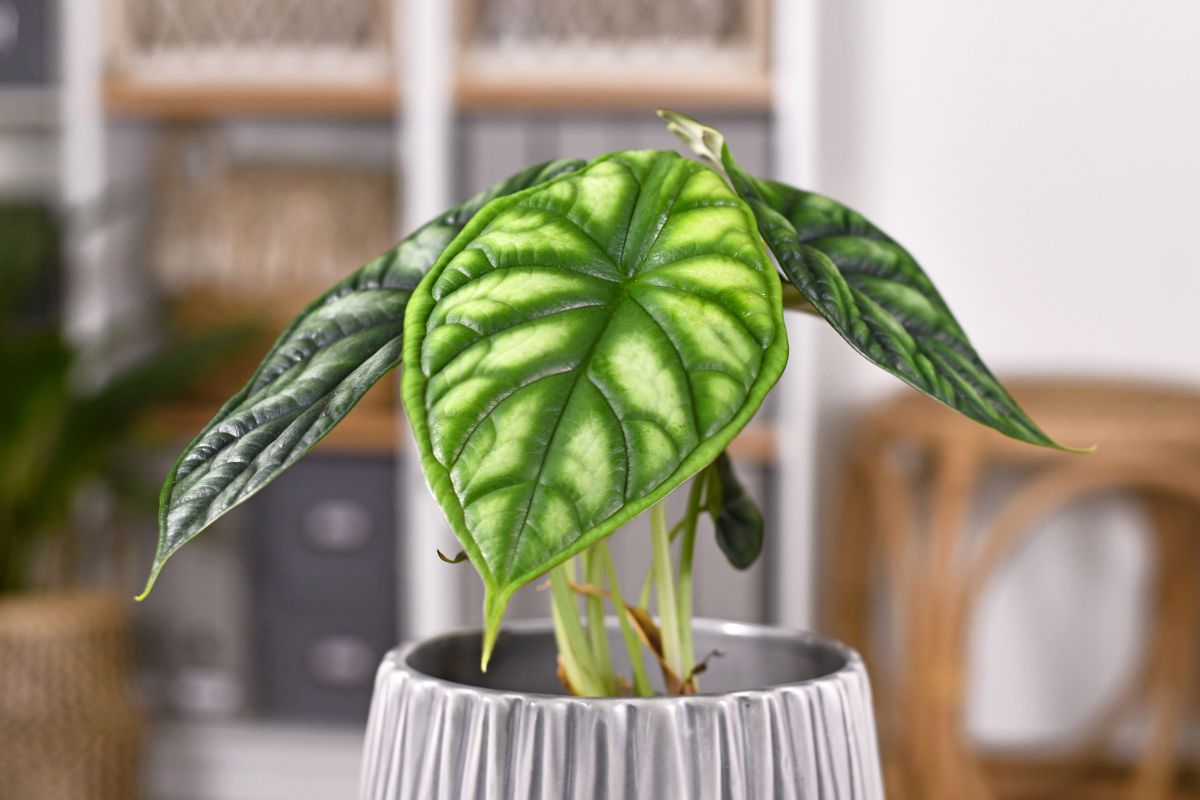
Alocasia, often called elephant ear plants, are part of the Araceae family. These tropical beauties come from Southeast Asia and are famous for their stunning leaves and unique look.
The leaves are large and arrow-shaped. They can be dramatic with prominent veins. Colors range from deep green to variegated patterns, sometimes showing shades of purple or silver.
Alocasia plants vary in size. Some can grow several feet tall, making them great as statement houseplants or in landscapes. They grow from rhizomes, producing new leaves in cycles, and thrive in warm, humid conditions. They grow quickly in humid environments.
Here are some popular Alocasia varieties:
- Alocasia x amazonica “Polly” – This hybrid has dark bronze-green, arrowhead-shaped leaves. The texture is leathery with slightly wavy edges.
- Alocasia baginda “Silver Dragon” – It features silver-white, heart-shaped leaves with dark green veins.
- Alocasia cuprea “Red Secret” – These have rounded leaves with deep veins and a shiny purple hue.
- Alocasia lauterbachiana “Purple Sword” – It has dark green and purple, arrowhead-shaped leaves that grow upright.
- Alocasia macrorrhizos “Giant Taro” – This can grow up to 15 feet tall and 8 feet wide. The leaves are large, measuring 3-4 feet long and 2-4 feet wide.
- Alocasia sanderiana “Kris” – It has very dark green, pointed leaves with white veins and scalloped edges with a white outline.
Most Alocasia species do well in shade or shady areas but prefer bright, filtered sunlight. Larger varieties can adapt to full tropical sunlight.
Keep all varieties humid, moist, and warm. Trim away faded leaves. The Alocasia blooms with a light yellow flower that is not very showy.
How to Care for an Alocasia Plant
Alocasia plants grow fast. Even in northern climates with short growing seasons, you can still grow Alocasia. During warmer months, they can produce a new leaf every week. Each new leaf might be bigger than the last one.
In late fall and winter, the plant goes dormant and stops growing. It stays the same size when it “sleeps”. If it gets too cold, it might die.
You still need to care for it during this time so that when it wakes up, it will start growing quickly again. Here’s what you should remember when caring for your Alocasia plant.
Soil Requirements for Alocasia
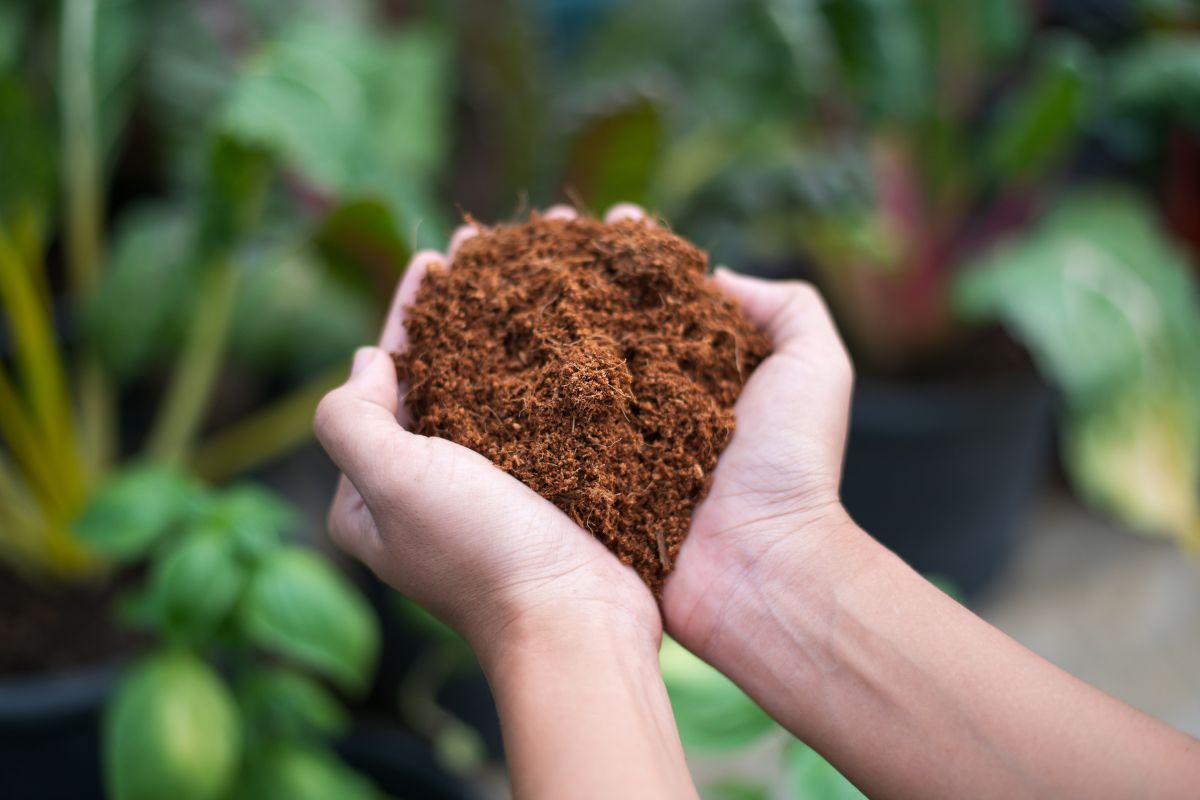
Alocasia plants, commonly known as Elephant Ears, thrive best in a specific soil mix that balances good drainage with recommended moisture levels. The ideal soil mix for Alocasia includes several key components to support their growth:
- Coco Coir – Provides excellent moisture retention, keeping the soil evenly moist without becoming waterlogged.
- Perlite – Enhances drainage, preventing water from pooling around the roots and ensuring good aeration.
- Mix With Orchid Bark – Adds structure to the soil mix, aiding in root development and allowing for better air circulation around the roots.
- Sphagnum Moss – Increases humidity around the plant, which is beneficial for Alocasia, especially in drier indoor environments.
- Worm Castings – Rich in nutrients and beneficial microbes, worm castings help to nourish the plant and support soil health.
- Horticultural Charcoal – Improves drainage and absorbs impurities, promoting a healthy root environment.
For a DIY soil mix, you can use a ratio of approximately 1 part coco coir, 1 part perlite, 1 part orchid bark, and optionally add 1 part worm castings for added nutrients.
There are also commercial soil options specifically formulated for Alocasia available:
You can also find commercial mixes on platforms like Etsy and Amazon, where you might also find options for free shipping or delivery fees, depending on the seller.
Temperature Requirements for Alocasia
Alocasia plants love warm and humid places. Keep daytime temperatures between 70-85°F (21-29°C) and nighttime temperatures no lower than (15-18°C).
Cold drafts and temperatures below 50°F (10°C) can harm them. Leaves might turn yellow and die back.
In summer, place Alocasia in bright but indirect light to avoid leaf burn. During winter, water less and keep the plant warm. Avoid heating vents or radiators as they dry out the soil and leaves.
With the right warmth, humidity, and proper watering, Alocasia will thrive. Watch the leaves for signs of stress due to wrong temperatures or watering.
Light Requirements for Alocasia
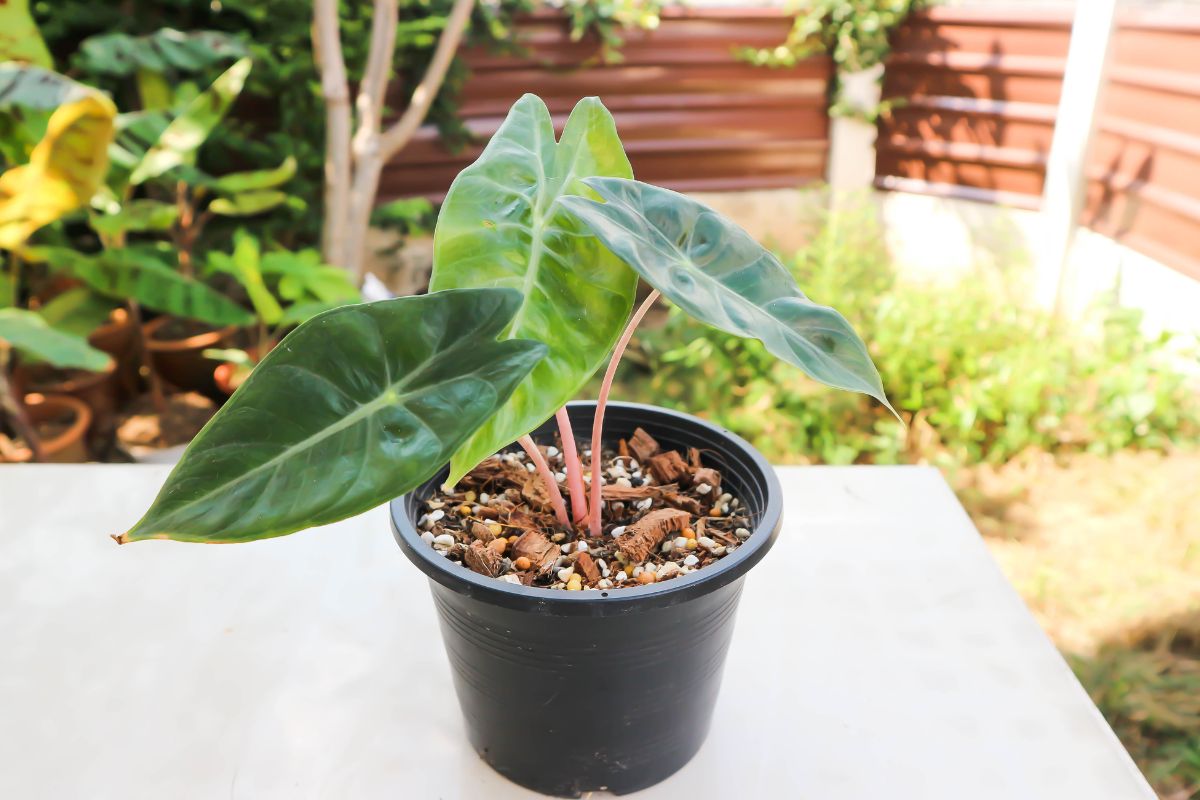
Alocasia plants love bright, indirect light. They can take a bit of direct sunlight, especially in the morning or evening. However, too much midday sun can burn their leaves.
In their natural habitat, Alocasia grows under the trees in tropical forests where the light is softer. To keep your Alocasia happy, try to mimic this filtered light at home.
Most Alocasia types are not fussy about day length. They can grow well in different light conditions. Still, some may grow and bloom better with longer days.
Alocasia leaves can turn toward the light. This is called heliotropism, and it helps them soak up more light when it’s dim.
Some Alocasia types, like Alocasia macrorrhiza, can handle more sunlight. They do well in brighter spots, while others prefer shadier areas.
Water and Humidity Requirements for Alocasia
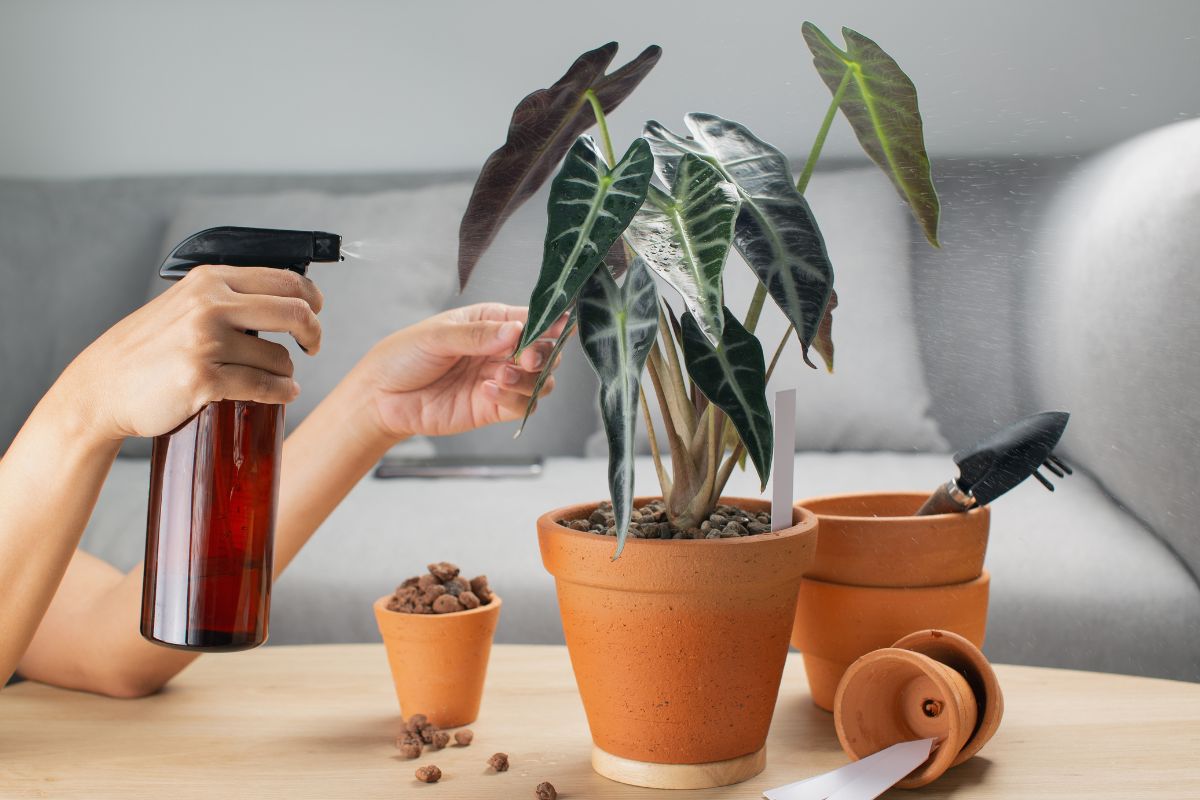
Alocasia plants thrive in consistently moist soil, but make sure they don’t sit in water. Let the top inch of soil dry out between waterings. In spring and summer, water your Alocasia once a week. In fall and winter, cut back to every 10-14 days.
If possible, use distilled or rainwater, as tap water might contain chemicals that could harm the plant. Alocasia also loves high humidity—ideally between 60% and 80%.
To keep the humidity up, try these tips:
- Place a tray with water and pebbles under the plant.
- Lightly mist the leaves regularly.
- Use a room humidifier.
Always keep your Alocasia away from heating vents or air conditioning units, which can dry out the air.
Fertilizer for Alocasia
Alocasia plants should be fertilized every 2-4 weeks during the growing season, as they are heavy feeders needing frequent nutrients for robust growth.
Always dilute liquid houseplant fertilizers to half the recommended strength to prevent nutrient burn, especially in potted plants with limited soil volume.
Use a balanced water-soluble fertilizer with a 20-20-20 N-P-K ratio, applied monthly during the growing season for healthy growth and vibrant foliage.
Organic options such as Gardenera Plant Growth Superfood, are available for $12.99 on Amazon. Gardenera’s formulation is enriched with 18 essential vitamins and minerals, ideal for Alocasia.
Slow-release fertilizers can be mixed into the soil at planting or top-dressed periodically, providing a hands-off approach and minimizing the risk of over-fertilization.
How to Prune and Repot Alocasia
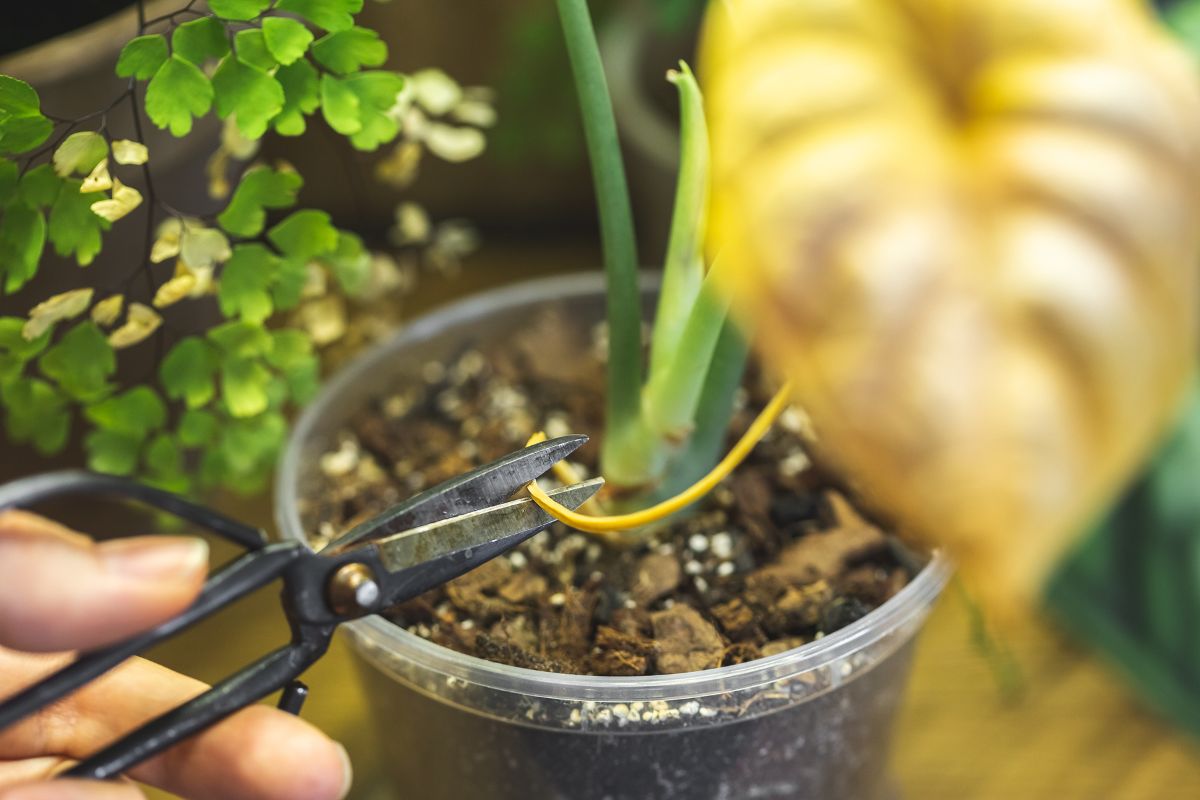
Pruning your Alocasia is easy and helps it grow well.
Start by cutting away dead wood. Remove old branches, twigs, and leaves because they don’t help your plant. For thick stems, cut back to three times the height of the pot. This encourages new growth.
Do this every other week until your plant is the size you want. When it’s time to repot, do it once a year. Pick a pot that is a few inches larger than the current one. Use fresh, well-draining soil to support your plant.
While repotting, think about dividing the rhizome. This keeps your Alocasia at a good size. You can also share new plants with friends or add to your own collection.
Here are some quick tips for pruning and repotting Alocasia:
- Remove dead leaves and branches regularly.
- Repot every year with fresh soil.
- Divide the rhizome when repotting.
How to Propagate Alocasia Plants
Propagating Alocasia can be a rewarding process, allowing you to expand your collection or share these stunning plants with others. Here are three ways to propagate your Alocasia plant:
- Division
- Propagation using tubers
- Tissue culture
The most common method for propagating Alocasia is division, which is ideal for mature plants. Here’s how you can do it:
- Carefully remove the Alocasia from its pot and gently shake off excess soil.
- Identify the rhizomes or tubers and separate them into sections, ensuring each section has 3-5 healthy leaves attached.
- Repot each section in well-draining soil and water thoroughly.
Alocasia can also be propagated using tubers, which are swollen stems growing underground. Follow these steps:
- Carefully uproot the plant and locate healthy tubers.
- Detach the tubers with a clean knife and allow them to dry for 1-2 days.
- Plant the tubers horizontally in fresh soil, ensuring the growing end points up, and water sparingly until new growth appears.
Tissue culture is an advanced method used primarily by professional growers to produce disease-free clones in a controlled lab setting.
After propagation, it’s important to provide proper care using these steps:
- Maintain high humidity levels around 50-60% to help the new plants establish.
- Provide bright, indirect light to promote healthy growth.
- Water regularly, but avoid overwatering to prevent root rot.
By following these methods and care tips, you can successfully propagate Alocasia and enjoy the beauty of these plants in your indoor garden or share them with fellow plant enthusiasts.
Alocasia Common Plant Pests, Diseases, and Problems
Even though Alocasia plants can be quite large and even intimidating due to their size, they are sensitive to a variety of diseases. The more common infections include:
- Leaf spots
- Powdery Mildew
- Bacterial Blight
- Root Rot
- Crown Rot
Your Alocasia might be unwell if you notice dark brown or black spots on the leaves with a yellow edge. This often means a disease is present, but you can prevent it by watering properly.
Don’t overwater your plant. Keep the leaves dry and make sure there is good air circulation. Yellow leaves usually come from too much water and can mean root rot. If the leaves droop and have brown edges, it may be due to low humidity. This can lead to yellowing, browning, and shriveling. Limp leaves can also happen if the soil dries out.
Too much direct sunlight can burn the leaves. If the light is too low, the leaves may turn yellow. When older leaves yellow while new growth appears, it often means your plant is putting energy into that new growth.
Common Alocasia pests include:
- Aphids
- Mealybugs
- Scale
- Spider Mites (Check the undersides of leaves for webbing)
Your Alocasia might be sick if you notice dark brown or black spots on the leaves with yellow edges. This often means a disease is present, but you can prevent it with the right watering.
Avoid overwatering because it can cause problems. Keep the leaves dry and make sure air circulates well around the plant. If the leaves turn yellow, it often means you are giving too much water, which can lead to root rot.
Drooping leaves with brown edges usually mean the humidity is too low. If this continues, the leaves may turn yellow, brown, or even shrivel. Limp leaves can also happen if the soil dries out too much.
Direct sunlight can burn the leaves. If the light is too low, the leaves may also turn yellow. When older leaves turn yellow while new ones grow, it usually means the plant is putting its energy into the new growth.
The Alocasia plant is very poisonous. Its leaves have oxalate crystals. If a pet, like a dog or cat, or a small child bites a leaf, these crystals can irritate the mouth.
This irritation can lead to swelling in the mouth, throat, and stomach. In severe cases, swelling can make it hard to breathe because it can block the airway.
To avoid these problems, keep your Alocasia out of reach of kids and pets. If someone bites or eats part of this plant, contact your local poison control, your doctor, or your vet right away.
Symptoms of oxalate crystal poisoning from Alocasia may include:
- Swelling
- Diarrhea
- Excessive drooling
- Blistering inside the mouth or in the throat
- Lack of appetite
- Nausea
- Pain in the mouth or throat
- Vomiting
Growing Alocasia Final Thoughts
The Alocasia houseplant stands out with its bold and eye-catching leaves. Many home gardeners love it because it adds a unique touch to any space.
Placing an Alocasia in your home will definitely grab attention. It not only improves your indoor decor but also becomes a conversation starter.
If you have room for a larger plant, consider one of the bigger Alocasia species. They thrive in bright areas like an entrance hall, lobby, or living room. Just remember to keep them away from pets since they can be toxic.
Growing Alocasia FAQs
1. Is Alocasia Good as an Indoor Plant?
Yes, the Alocasia is a good indoor plant and as a tropical plant, it does need plenty of light. The Alocasia needs bright indirect sunlight. They love water, so be sure to water them regularly during dry periods, and mist them occasionally when needed. The Alocasia leaves are beautiful and will grab the attention of your visitors indoors and out.
2. Is Alocasia Easy to Care For?
It’s very simple to take care of the Alocasia. You just need to give it enough indirect, bright light and regular watering. Water deeply once every week if not watered daily. Do not let the soil get too wet, but also not too dry. Avoid direct sunlight, which could burn the leaves. Remove dead leaves promptly.
3. Why Is My Alocasia Plant Dying?
There are many reasons why your Alocasia might die. Some common problems that can kill your plants are:
- Overwatering or underwatering
- Overfeeding or nutrient deficiency
- Poor water drainage
- Lack of sun exposure
- Pests such as aphids, mites, spider mite, whiteflies, scale insects, slugs, snails, ants, etc.
- Diseases like bacterial wilt, fungal diseases, viruses– Environmental factors.
Go through each one and the process of elimination.
4. How Often Should You Water Alocasia?
Look to water your Alocasia at least once per week as these are tropical plants. If you live in a drier climate, then you’ll want to water more frequently than those who reside in wet climates. In cold temperatures, water less frequently.
5. Does Alocasia Like to Be Misted?
You don’t necessarily need to mist your Alocasia. However, they do enjoy being sprayed periodically throughout their growing season. This helps prevent disease and pests while keeping the leaves looking fresh.
6. When Should I Repot Alocasia?
Repotting Alocasia is recommended each year as they grow quickly. Repot into a large container with fresh potting soil that drains well. Be careful not to overfill the pot.
For more houseplant care and grow guides, look at these articles:









